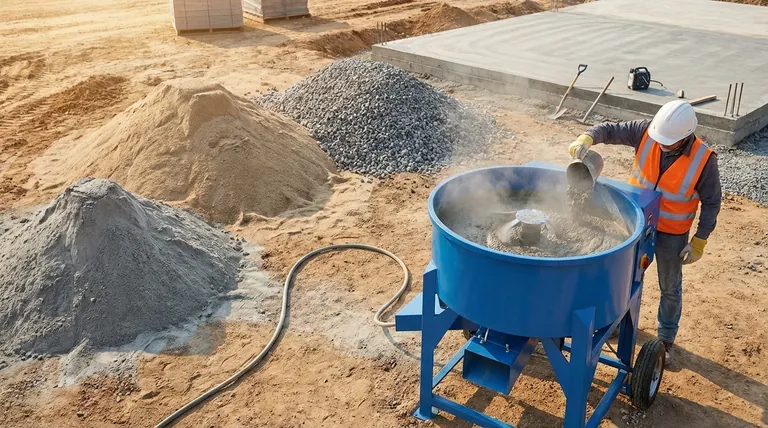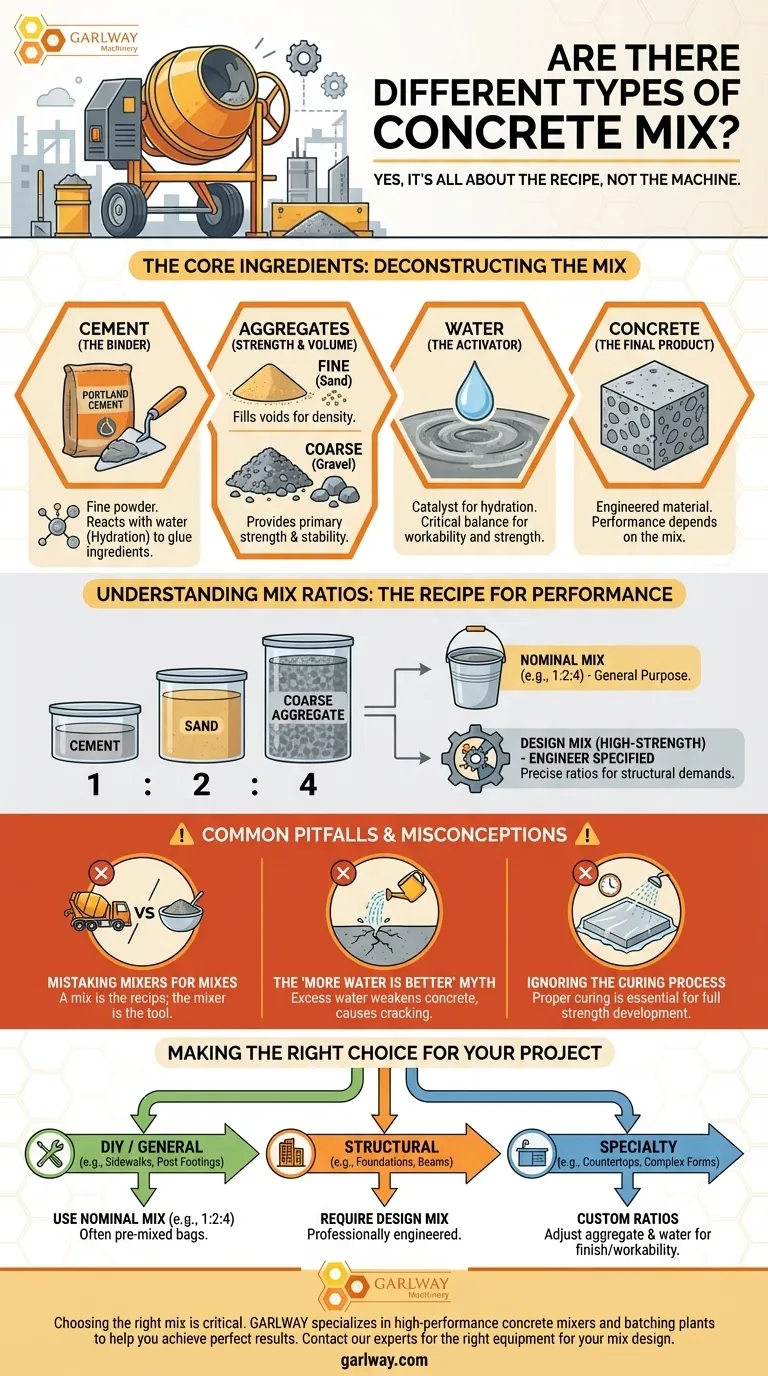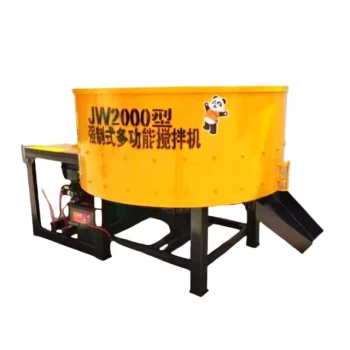Yes, there are many different types of concrete mixes. The "type" of concrete mix is not defined by the machinery used to mix it, but by the specific ratio of its core ingredients: cement, sand, aggregate (like gravel), and water. A common general-purpose mix, for example, uses a ratio of 1 part cement, 2 parts sand, and 4 parts aggregate.
The crucial insight is that a concrete "mix" is a recipe designed for a specific purpose. By altering the proportions of the ingredients, you change the concrete's final strength, durability, and workability to match the demands of the job, from a simple garden path to a structural foundation.

Deconstructing the Concrete Mix: The Core Ingredients
To understand different mixes, you first need to understand the role of each component. Concrete is an engineered material, and every ingredient serves a distinct and vital purpose.
Cement: The Binder
Portland cement is the fine, gray powder that acts as the binding agent. When mixed with water, it undergoes a chemical reaction called hydration, forming a paste that hardens and glues all the other ingredients together.
Aggregates: The Strength and Volume
Aggregates are the granular materials that make up the bulk of the concrete. They are split into two categories:
- Fine Aggregate (Sand): Fills the voids between the larger pieces, creating a denser, more compact final product.
- Coarse Aggregate (Gravel or Crushed Stone): Provides the primary strength and stability for the concrete.
Water: The Activator
Water is the catalyst that initiates the hydration process in the cement. The amount of water is critical; it must be enough to activate the cement and make the mix workable, but not so much that it compromises the final strength.
Understanding Mix Ratios: The Recipe for Performance
The key differentiator between concrete mixes is the ratio in which the ingredients are combined. This ratio, often called the mix design, directly dictates the performance characteristics of the hardened concrete.
What Do the Numbers Mean? (e.g., 1:2:4)
A common mix ratio like 1:2:4 represents the proportions by volume of Cement : Sand : Coarse Aggregate. This is a standard, general-purpose recipe suitable for many non-structural applications like sidewalks or small slabs.
Nominal Mixes: The Standard Recipes
Mixes defined by simple, pre-set volume ratios (like 1:2:4 or 1:3:6) are known as nominal mixes. They are convenient for smaller projects where extreme precision is not required and the final strength is not a critical engineering parameter.
High-Strength vs. General-Purpose Mixes
A high-strength mix for a foundation will have a higher proportion of cement and a carefully controlled water-cement ratio compared to a general-purpose mix. This makes it more durable and able to withstand greater loads, but also more expensive.
Common Pitfalls and Misconceptions
Understanding what a concrete mix is also means understanding what it is not. Several common points of confusion can lead to project failures.
Mistaking Mixers for Mixes
The references often confuse the equipment with the product. A mixer (drum mixer, batch mixer, truck) is the machine used to combine the ingredients. A mix is the recipe of those ingredients. You can create any mix in any appropriate mixer.
The "More Water is Better" Myth
One of the most frequent mistakes is adding too much water to make the concrete easier to pour. Excess water significantly weakens the final product by increasing the space between aggregate particles, leading to porous and brittle concrete that is prone to cracking.
Ignoring the Curing Process
The recipe is only half the battle. After the concrete is placed, it must be properly cured—kept moist and at a stable temperature for a period of time. Skipping this step prevents the cement from fully hydrating, drastically reducing the final strength regardless of how good the mix was.
Making the Right Choice for Your Project
Selecting the appropriate mix comes down to matching its properties to your project's specific needs.
- If your primary focus is general DIY projects (e.g., post footings, small patio slabs): A standard nominal mix like 1:2:4, often available in pre-mixed bags, is typically the most practical and cost-effective choice.
- If your primary focus is high-strength structural work (e.g., foundations, beams, load-bearing columns): This requires a professionally engineered "design mix" with specific performance criteria that should only be specified by an engineer.
- If your primary focus is a specific finish or workability (e.g., countertops, complex forms): The mix will need careful adjustments to the aggregate size and water-cement ratio, often requiring specialized knowledge to achieve the desired result.
Ultimately, choosing the right concrete mix is about selecting the correct recipe for the task at hand.
Summary Table:
| Mix Type | Typical Ratio (Cement:Sand:Aggregate) | Common Applications |
|---|---|---|
| General-Purpose (Nominal) | 1:2:4 | Sidewalks, small slabs, post footings |
| High-Strength (Design) | Varies (Engineer Specified) | Foundations, beams, load-bearing columns |
| Specialty Mixes | Custom Ratios | Countertops, complex forms requiring specific finishes |
Choosing the right concrete mix is critical for your project's success. GARLWAY specializes in providing high-performance construction machinery, including reliable concrete mixers and batching plants, to help construction companies and contractors globally achieve perfect results. Let us help you select the right equipment for your mix design—contact our experts today to discuss your specific needs!
Visual Guide

Related Products
- Ready Mixer Machine for Construction Ready Mix Machinery
- Commercial Construction Mixer Machine for Soil Cement Mixing Concrete
- Auto Concrete Cement Mixer Machine New
- HZS90 Large Multiquip Concrete Mixers for Construction
- JDC350 Small Cement Concrete Mortar Mixer
People Also Ask
- What is the function of a concrete mixer machine? Achieve Consistent, High-Quality Concrete for Your Projects
- When was the first concrete mixer developed and by whom? Discover the 1900 Breakthrough
- Can a concrete mixer be used for mortar? Understanding the trade-offs for your project
- What should be considered regarding the output of a concrete mixer? Match Capacity to Your Project Scale
- Why is cleaning a concrete mixer after use important? Avoid Costly Repairs and Ensure Quality



















